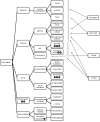Comprehending the impact of low vision on the lives of children and adolescents: a qualitative approach
- PMID: 27076189
- PMCID: PMC5010827
- DOI: 10.1007/s11136-016-1292-8
Comprehending the impact of low vision on the lives of children and adolescents: a qualitative approach
Abstract
Purpose: To develop a comprehensive, conceptual model detailing the aspects of a child's life (<18 years) that are affected by low vision.
Methods: Three stakeholders were involved in the developmental process of the conceptual model: children and adolescents with a visual impairment (n = 40), parents of children with a visual impairment (n = 25) and professionals of multidisciplinary rehabilitation centres and specialised schools (n = 25). Qualitative methods including focus groups, online and face-to-face brainstorming sessions and concept mapping were used to investigate the impact of visual impairment on the lives of children and adolescents and to create the conceptual model. To aid interpretation of the large age range, four age-bands were formed.
Results: For each age-band (0-2, 3-6, 7-12 and 13-17 years), a total of 153, 200, 297 and 306 statements were generated by all stakeholders, respectively. The conceptual models show that low vision affects the sensorial development as well as the physical, psychological and social well-being of children and adolescents. In addition, identified external factors (i.e. education/employment and parental influence) can either facilitate or hinder participation.
Conclusions: The developed model shows which life aspects of children are affected by low vision. The needs identified by children and adolescents correspond not entirely to the perspective of parents and low vision professionals. Future research should focus on developing and validating a new questionnaire based on the conceptual model. This will aid goal setting, rehabilitation referral and the accomplishment of developmental milestones and life transitions of children and adolescents with a visual impairment, ultimately improving their participation and quality of life.
Keywords: Adolescents; Children; Concept mapping; International Classification of Functioning, Disability and Health for Children and Youth; Visual impairment.
Conflict of interest statement
A grant for this study was provided by Royal Dutch Visio. The authors declare that they have no conflict of interest.
Figures


Similar articles
-
Impact of visual impairment on the lives of young adults in the Netherlands: a concept-mapping approach.Disabil Rehabil. 2017 Dec;39(26):2607-2618. doi: 10.1080/09638288.2016.1236408. Epub 2016 Oct 29. Disabil Rehabil. 2017. PMID: 27794635
-
Evaluating rehabilitation goals of visually impaired children in multidisciplinary care according to ICF-CY guidelines.Acta Ophthalmol. 2014 Nov;92(7):689-96. doi: 10.1111/aos.12319. Epub 2013 Dec 24. Acta Ophthalmol. 2014. PMID: 24373409
-
Investigating rehabilitation needs of visually impaired young adults according to the International Classification of Functioning, Disability and Health.Acta Ophthalmol. 2015 Nov;93(7):642-50. doi: 10.1111/aos.12782. Epub 2015 Jun 24. Acta Ophthalmol. 2015. PMID: 26109392
-
Quality of life, functioning and participation of children and adolescents with visual impairment: A scoping review.Res Dev Disabil. 2024 Aug;151:104772. doi: 10.1016/j.ridd.2024.104772. Epub 2024 Jun 12. Res Dev Disabil. 2024. PMID: 38870675
-
Interventions to improve functioning, participation, and quality of life in children with visual impairment: a systematic review.Surv Ophthalmol. 2019 Jul-Aug;64(4):512-557. doi: 10.1016/j.survophthal.2019.01.010. Epub 2019 Jan 28. Surv Ophthalmol. 2019. PMID: 30703405
Cited by
-
Network Analysis of the Participation and Activity Inventory for Children and Youth (PAI-CY) 7-12 Years with Visual Impairment.Transl Vis Sci Technol. 2020 May 19;9(6):19. doi: 10.1167/tvst.9.6.19. eCollection 2020 May. Transl Vis Sci Technol. 2020. PMID: 32821516 Free PMC article.
-
Psychometric evaluation of the Participation and Activity Inventory for Children and Youth (PAI-CY) 0-2 years with visual impairment.Qual Life Res. 2020 Mar;29(3):775-781. doi: 10.1007/s11136-019-02343-1. Epub 2019 Oct 31. Qual Life Res. 2020. PMID: 31673921 Free PMC article.
-
Translation and cross-cultural adaptation of a Nepali version of the Dutch Participation and Activity Inventory for Children and Youth (PAI - CY) with visual impairment.J Patient Rep Outcomes. 2021 Aug 25;5(1):77. doi: 10.1186/s41687-021-00342-w. J Patient Rep Outcomes. 2021. PMID: 34432179 Free PMC article.
-
Visual Impairment and Suicide Risk: A Systematic Review and Meta-Analysis.JAMA Netw Open. 2024 Apr 1;7(4):e247026. doi: 10.1001/jamanetworkopen.2024.7026. JAMA Netw Open. 2024. PMID: 38630473 Free PMC article.
-
Individual, family, and environmental determinants of vision-related quality of life of children and young people with visual impairment.PLoS One. 2023 Nov 16;18(11):e0294532. doi: 10.1371/journal.pone.0294532. eCollection 2023. PLoS One. 2023. PMID: 37972022 Free PMC article.
References
-
- Keunen JEE, Verezen CA, Imhof SM, van Rens GHMB, Asselbergs MB, Limburg JJ. Increase in the demand for eye-care services in the Netherlands 2010–2020 (Toename in de vraag naar oogzorg in Nederland 2010–2020) Ned tijdschr genees. 2011;155(41):1–6. - PubMed
-
- Zambone AM. Serving the young child with visual impairments: An overview of disability impact and intervention needs. Infants Young Child. 1989;2(2):11–23. doi: 10.1097/00001163-198910000-00004. - DOI
-
- Cole PG, Pheng LC. The effects of verbal mediation training on the problem solving skills of children with partial sight and children without visual impairments. International Journal of Disability, Development and Education. 1998;45(4):411–422. doi: 10.1080/1034912980450404. - DOI
MeSH terms
LinkOut - more resources
Full Text Sources
Other Literature Sources

